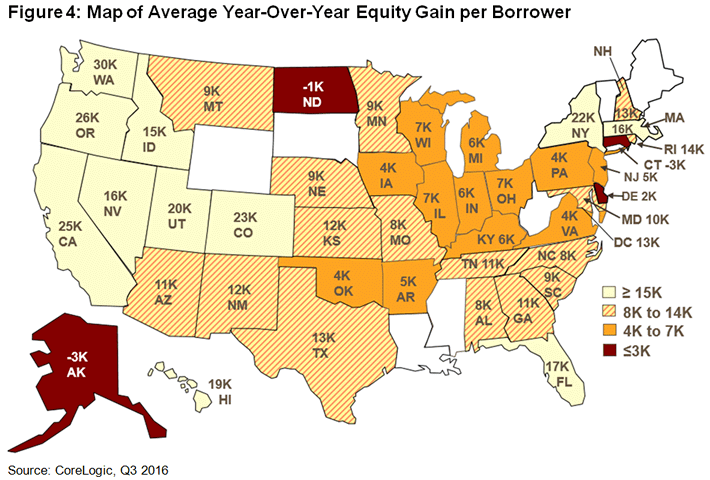The number of "underwater" homeowners continued to decrease at a rapid pace in the third quarter of 2016 as home values grew. Negative equity, often referred to as "underwater" or "upside down," applies to borrowers who owe more on their mortgages than their homes are worth. CoreLogic said on Thursday that 384,000 homeowners regained positive equity in their homes during the quarter, dropping the number in negative territory to 3.2 million or 6.3 percent of all mortgaged homes.
In the second quarter of 2016 the number of underwater properties totaled 3.6 million and in the third quarter of 2015, 4.2 million. The most recent number represents a quarter-over-quarter and a year-over-year decrease of 10.7 percent and 24.1 percent respectively. Based on CoreLogic negative equity data, which goes back to Q3 2009 negative equity peaked at 26 percent of mortgaged residential properties in the fourth quarter of that year.
The aggregate value of the negative equity remaining at the end of the third quarter was $282 billion, down $2.1 billion or 0.8 percent from the second quarter and $25 billion or 8.2 percent from one year earlier.

Nationwide, homeowners with mortgages (approximately 63 percent of all homeowners) gained a total of $227 billion in equity during the third quarter, 3.1 percent more than was gained in Q2. Approximately 47.9 million homes with mortgages now have positive equity or 93.7 percent. From the third quarter of 2015 to the same quarter of 2016 home equity nationwide grew by $726 billion, an increase of 10.8 percent.
"Home equity rose by $12,500 for the average homeowner over the last four quarters," said Dr. Frank Nothaft, chief economist for CoreLogic. "There was wide geographic variation with homeowners in California, Oregon and Washington gaining an average of at least $25,000 in home equity wealth, while owners in Alaska, North Dakota and Connecticut had small declines, on average."

"Price appreciation is the main ingredient for home equity wealth creation, and home prices rose 5.8 percent in the year ending September 2016 according to the CoreLogic Home Price Index," said Anand Nallathambi, president and CEO of CoreLogic. "Paydown of principal is the second key component of equity building. Many homeowners have refinanced into shorter-term loans, such as a 15-year loan, and by doing so, they have significantly fewer mortgage payments and are able to build equity wealth faster."
Texas, Alaska, Colorado, Utah, and Washington had the highest percentage of homes with positive equity - all closely grouped around 98 percent. The highest percentage of underwater homes were in Nevada at 14.2 percent and Florida with 12.5 percent. Illinois, Arizona, and Rhode Island all were in the 10 to 11 percent range. These top five states combined accounted for 30.6 percent of negative equity mortgages in the U.S., but only 16.3 percent of outstanding mortgages.
The bulk of home equity for mortgaged properties is concentrated at the high end of the housing market. For example, 96 percent of homes valued at greater than $200,000 have equity compared with 90 percent of homes valued at less than $200,000.







